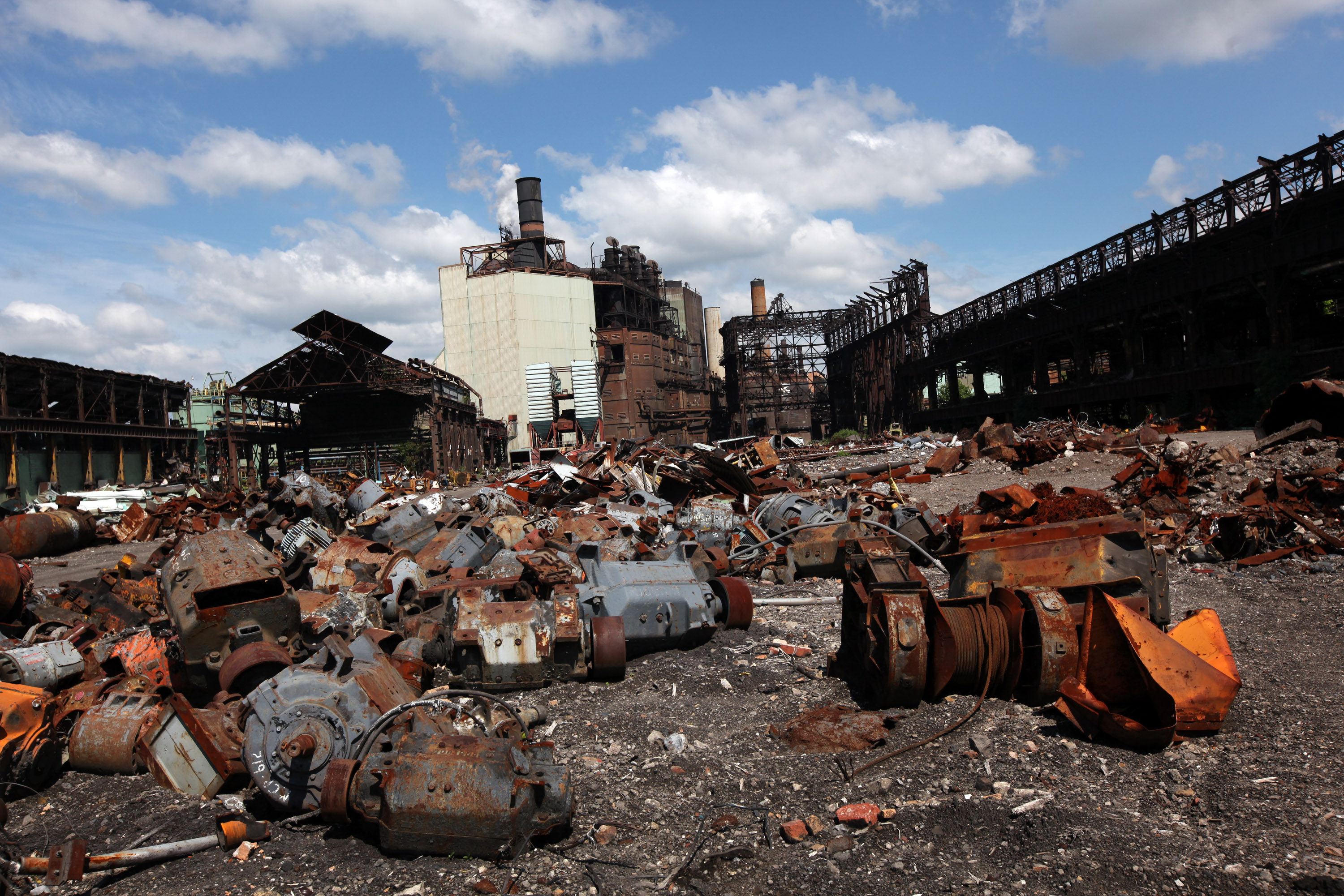Can President Trump rescue the Rust Belt?
He promised to reverse the decades-long decline of manufacturing jobs. Can it be done?

President Trump promised to reverse the decades-long decline of manufacturing jobs. Can it be done? Here's everything you need to know:
Why is the Rust Belt hurting?
Once the booming heart of America's manufacturing industry, the Rust Belt is now dotted with derelict factory buildings, empty warehouses, and struggling downtowns filled with pawnshops and boarded-up stores. The region, which stretches from western New York to Pennsylvania, Ohio, Michigan, Indiana, Illinois, and Wisconsin, has been in serious decline since 1979 — the year that U.S. manufacturing employment peaked. Over the past four decades, manufacturing jobs have plunged by 7 million as factories have downsized, closed, and outsourced work to low-wage countries such as Mexico and China. Young people have fled these blighted communities, and amid poverty and hopelessness, a growing number of those left behind have turned to opioids and other drugs to cope. In 2016, much of this once heavily unionized region flipped for Trump, who promised to "remove the rust from the Rust Belt" by renegotiating trade deals and slapping tariffs on imports. "We will stop these countries from taking our jobs," Trump said while campaigning in Erie, Pennsylvania. "I promise we can fix it so fast."
The Week
Escape your echo chamber. Get the facts behind the news, plus analysis from multiple perspectives.

Sign up for The Week's Free Newsletters
From our morning news briefing to a weekly Good News Newsletter, get the best of The Week delivered directly to your inbox.
From our morning news briefing to a weekly Good News Newsletter, get the best of The Week delivered directly to your inbox.
What does Trump intend to do?
Trump already claims credit for pressuring several companies, including Carrier, to keep or create jobs in the U.S. In November, the Indiana air-conditioning manufacturer announced it would choose not to move 800 jobs to Mexico, in exchange for various economic incentives. But even if Trump made similar deals every week for the next four years, he would bring back only 4 percent of the manufacturing jobs lost since 2000, according to a New York Times analysis. On a broader level, Trump has floated the possibility of tariffs and import taxes of 20 to 35 percent on products made in Mexico, China, and other countries. Calling trade deals "the greatest jobs theft in history," the president has also vowed to renegotiate NAFTA.
Will these policies work?
Few economists think so: The reality is that trade deals have played only a small part in the Rust Belt's decline. The U.S. lost half its manufacturing jobs before 1994 — the year NAFTA took effect, and seven years before China joined the World Trade Organization. The much bigger culprit in job loss was the one that has taken the "man" out of manufacturing: automation. About 85 percent of the 5 million factory jobs lost between 2000 and 2010 can be blamed on technology and robots, according to a Ball State University study (see below). That's why virtually all economists agree that bringing back millions of lost jobs is unlikely. "Trump deserves credit for taking seriously the anxieties and anger and frustrations in these communities," said Mark Muro, a specialist in economic development at the Brookings Institution. But Trump's promise to bring back millions of jobs is a "pipe dream," he says — and could backfire.
A free daily email with the biggest news stories of the day – and the best features from TheWeek.com
Who could be hurt?
If Trump adopts a protectionist trade policy, it would likely result in retaliatory tariffs on U.S. exports to Canada, China, Mexico, and other countries. A trade war would badly hurt American farmers, who get 30 percent of their revenue from exporting produce and meat abroad. Major U.S. corporations derive 40 percent of their profits from foreign sales and would have to lay off workers if there were a trade war.
So are Rust Belt workers doomed?
Not necessarily. But economists agree they do need to be retrained for the new manufacturing age, which requires workers who can program and operate computers and robots. The U.S. will need to fill 3.5 million skilled jobs in specialized manufacturing over the next decade, according to a 2016 White House report. To help fill that demand, the Trump administration could create training programs that connected community colleges to local companies. Another job-growth area is health and educational services, with positions for nurses, health-care aides, and teachers; that sector grew 43 percent in several Rust Belt states between 1996 and 2016. But the potential for service jobs and manufacturing retraining is limited: Many blue-collar men in their 40s and 50s see service jobs as "women's work," and are intimidated by the idea of being retrained to operate computers. For that reason, some social scientists have offered a more drastic solution.
What's that?
Relocation. Henry Olsen, a senior fellow at the Ethics and Public Policy Center, says lawmakers should pass a New Homestead Act that would subsidize people who want to leave the Rust Belt for booming urban areas like Houston and Los Angeles. In these areas, job growth is brisk. A Brookings study of a similar relocation experiment from the 1990s, known as "Moving to Opportunity," found that poor families who relocated with help from the Department of Housing and Urban Development often ended up happier and healthier than families who stayed behind. Many of the Rust Belt's historic steel towns and manufacturing hubs simply cannot be saved, says Galen Newman, assistant professor of urban planning at Texas A&M. "I think we're going to have to let some of them go," says Newman.
Why robots replaced people
Contrary to rumor, U.S. manufacturing is not in decline. The value of goods manufactured in this country hit at all-time high last year. But because of automation, it takes far fewer employees to make those goods today than during the Rust Belt's golden era. Today, for example, a spot-welding robot in the auto industry costs the employer $8 an hour, compared with $25 for a worker. And robots are getting more sophisticated every year. One such machine from Universal Robots can solder, paint, screw, glue, and grasp items — and even repair itself when damaged. "A steel mill like we have here, 20 years ago, it would have to be run by 5,000 or 6,000 people," says Ohio State Sen. Sean O'Brien. "Now it's 800 people, because of automation." As technology becomes ever more sophisticated, job losses will grow, not diminish. A 2013 study projected that as many as 47 percent of U.S. jobs could be lost to automation and robots over the next two decades.
-
 Most data centers are being built in the wrong climate
Most data centers are being built in the wrong climateThe explainer Data centers require substantial water and energy. But certain locations are more strained than others, mainly due to rising temperatures.
-
 ‘Maps are the ideal metaphor for our models of what the world might be’
‘Maps are the ideal metaphor for our models of what the world might be’Instant Opinion Opinion, comment and editorials of the day
-
 What is China doing in Latin America?
What is China doing in Latin America?Today’s Big Question Beijing offers itself as an alternative to U.S. dominance
-
 Bari Weiss’ ‘60 Minutes’ scandal is about more than one report
Bari Weiss’ ‘60 Minutes’ scandal is about more than one reportIN THE SPOTLIGHT By blocking an approved segment on a controversial prison holding US deportees in El Salvador, the editor-in-chief of CBS News has become the main story
-
 Has Zohran Mamdani shown the Democrats how to win again?
Has Zohran Mamdani shown the Democrats how to win again?Today’s Big Question New York City mayoral election touted as victory for left-wing populists but moderate centrist wins elsewhere present more complex path for Democratic Party
-
 Millions turn out for anti-Trump ‘No Kings’ rallies
Millions turn out for anti-Trump ‘No Kings’ ralliesSpeed Read An estimated 7 million people participated, 2 million more than at the first ‘No Kings’ protest in June
-
 Ghislaine Maxwell: angling for a Trump pardon
Ghislaine Maxwell: angling for a Trump pardonTalking Point Convicted sex trafficker's testimony could shed new light on president's links to Jeffrey Epstein
-
 The last words and final moments of 40 presidents
The last words and final moments of 40 presidentsThe Explainer Some are eloquent quotes worthy of the holders of the highest office in the nation, and others... aren't
-
 The JFK files: the truth at last?
The JFK files: the truth at last?In The Spotlight More than 64,000 previously classified documents relating the 1963 assassination of John F. Kennedy have been released by the Trump administration
-
 'Seriously, not literally': how should the world take Donald Trump?
'Seriously, not literally': how should the world take Donald Trump?Today's big question White House rhetoric and reality look likely to become increasingly blurred
-
 Will Trump's 'madman' strategy pay off?
Will Trump's 'madman' strategy pay off?Today's Big Question Incoming US president likes to seem unpredictable but, this time round, world leaders could be wise to his playbook